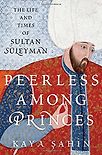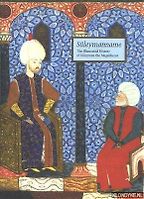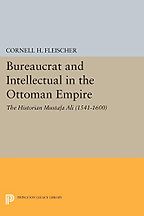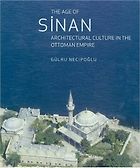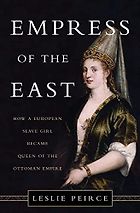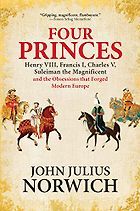Before we get to the books, can you just tell us a bit about who Süleyman was and why he’s significant? Why might people be interested in learning—or learning more—about him?
Süleyman was the ruler of the Ottoman Empire from 1520 to 1566, a time of major transformations in the Middle East, in Europe, across Eurasia and indeed globally. This was a time when early modern empires and states were expanding. It was a period of increased commercial activity, global communication, as well as heightened religious sensibilities, including apocalyptic and messianic speculations. Süleyman responded to these developments in ways that had an impact on the lives of millions of people living in the Middle East, in Europe, and Eurasia. He is significant in this regard, as a world historical figure.
These global transformations are almost always described from a European perspective. Thus, the story of Süleyman is also important because it makes us realize the extent to which major European figures of the time—like Charles V or Francis I—interacted with the Ottomans and responded to them. Studying or reading about Süleyman tells us about this missing chunk in world history, it helps us complete the narrative.
Of course, the Ottomans are not the only non-European dynasty that is often left out. We have the Safavids, the Mughals, the Ming and then the Qing in China. Ivan IV, the czar of Muscovy, who was a close contemporary of Süleyman, is often left out of the narrative as well. Through Süleyman, I wanted to add a crucial component to the account of major global transformations, which is usually told from a Eurocentric perspective.
In terms of Süleyman’s own story, there are various elements that make his life interesting. For instance, he was not predestined to become sultan. Rather, he grew up with the distinct possibility of being killed during a succession struggle. His is the story of someone who grew up in a fratricidal dynastic culture, under the shadow of a violent, overbearing father. He then came to the throne in his mid-20s, as a relatively inexperienced prince. He tried to establish a nuclear family and an intimate life in the middle of the harem. But, because of the restrictions of the dynastic culture in which he lived, he ended up condoning the deaths of a number of his children and grandchildren. He spent the last few decades of his life trying to stay in power, to stay relevant, to construct a legacy that would erase the tensions and problems of his life and rule.
I think there is also an intriguing discussion about human agency versus structure. To what extent could you instigate change in 16th-century society? What was the cost? How much could you change the large structures you were a part of, even if you were at the top of the pyramid?
These are the reasons I think it’s interesting for people who like history to read a biography of Süleyman.
Süleyman was the longest-ruling Ottoman sultan. Is his reign the apex of the Ottoman Empire? Is it at its largest size, during this period?
Süleyman’s rule is seen as the apex of the Ottoman Empire, but not necessarily because of territorial expansion—a couple of Süleyman’s descendants in the late 16th century did expand it further. Under Süleyman, the empire did get close to reaching its largest territorial limits though, occupying today’s Iraq, parts of the Caucasus, Northern Africa and so on.
But his reign is mostly seen as the apex of the Ottoman Empire because of institutionalization. Under Süleyman, there was a critical level of bureaucratization. There was significant legislative activity, which enhanced dynastic law, and supplemented the sharia with different legal elements that made it easier to manage the Empire.
This is a selective reading, though, as I talk about in the conclusion of my book. It is very much conditioned by the political circumstances of the 19th and 20th centuries, when politicians and intellectuals looked to the Ottoman past to find precedents of rational bureaucratic or orderly rule, or military glory. It’s an image that was constructed in bits and pieces in the 19th and 20th centuries.
“He was fairly unknown when he became sultan”
That’s another reason why I wrote my biography. I wanted to situate Süleyman within his period and beyond these posthumous reconstructions. There were a lot of military victories, but there were also a lot of military stalemates. When you look at Süleyman’s intentions and his achievements, you can say that he failed on a number of levels. When we talk about institutionalization, we have to realize this was a very large territorial empire. If there was a crisis in Egypt for instance, it might take several weeks for the local governor to convey the problem to Istanbul to get back a response, of course, if the ship carrying the message didn’t sink or, if you were sending it by horse, the messenger survived the trip. I wanted to talk about the whole thing—the achievements as well as the failures, the dreams as well as the outcomes. I wanted to offer a complex picture as opposed to the simplifications that had been piling up, especially after Süleyman died.
Also, it is important to note that his reign is considered the apex of the Ottoman Empire because Süleyman was very skilled in reputation building. This started immediately on his arrival to the throne, because he was fairly unknown when he became sultan. He had to struggle with the legacy of his father, first of all. When his father Selim came to the throne, in 1512, he had done so after rebelling against Süleyman’s grandfather. As sultan, Selim won three major field battles and expanded the empire’s territory almost twofold. Everybody in the Ottoman realm and beyond knew of him and his actions. In contrast, Süleyman, as prince, was known as a good son. He was docile, he did the job. To get away from under his father’s shadow, as soon as he became sultan, he started building his reputation, and he continued throughout his life.
Let’s turn to the books you’ve chosen. Let’s start with Suleymanname: The Illustrated History of Suleyman the Magnificent, edited by the art historian, Esin Atil. What’s this book about?
In the last decades of his life, Süleyman commissioned a work on his reign, and the result is a history in verse, written in Persian, with magnificent illustrations, called the Süleymanname, i.e., the Book of Süleyman. Esin Atil’s study is based on the original. She doesn’t offer a full translation, but I don’t think it is necessary, as the flowery, classicized language would be quite inaccessible for today’s readers. Instead, she offers a long and informative introduction to Süleyman’s reign and the art and culture of the Ottoman elite, then reproductions of all the illustrations in the Süleymanname, accompanied with detailed descriptions and interpretations by a skilled, perceptive art historian. At the end, there’s a very detailed index, a conceptual index. There’s also a dramatis personae-type section where individuals are matched with their depictions in the illustrations. It’s really amazingly done.
This is one of the two best books (the second one we will discuss next) that we have about Süleyman’s attempts at creating his own legacy visually. This is the first one I would recommend because it represents Süleyman’s own view of his legacy at a very difficult time in his life. The composition of the Süleymanname started in the second half of the 1540s, when Süleyman was increasingly feeling the impact of physical illness. He had gout and digestive problems. This was also a time when his sons were beginning to emerge as candidates to the sultanate. Pretty much everybody in the Ottoman realm—as well as the diplomatic observers, such as the French and the Italians—were expecting a succession struggle soon.
It was also a time of reflection for Süleyman. His major military campaigns and his imperialist agenda were very much projects associated with his earlier years on the throne. When he was younger, he had developed this image as a messianic conqueror who was going to bring peace to east and west. By the late 1530s, his ambitious youth projects had not necessarily been failures—they did lead to considerable territorial extension and the expansion of the sultan’s power—but, at the same time, they had led to entanglements with the Safavids and the Habsburgs which looked more and more like stalemates.
The 1540s thus marked a time when Süleyman was becoming much keener on institutionalization and legislative activity. As I mentioned before, he had always been careful about his image, but this was also the time that he started focusing on—to use an expression that my wife came up with, which I love—his self-curated legacy. That’s what he was doing, and the Süleymanname was a part of that attempt.
The original manuscript is in the Topkapi museum in Istanbul, is that right?
Yes, it’s in the Topkapi Palace Library. There’s only a single copy and the manuscript is intact, which is unusual. Some people think this shows it had limited readership. I think it was widely read, but by the innermost circle. It must have been seen as one of the crown jewels of Ottoman dynastic culture throughout the centuries by people who saw it.
The manuscript was illustrated and inscribed by a team of really accomplished artists and artisans. It took around 10 years to finish. I’m fairly certain Süleyman, who knew Persian very well, discussed the text with the author whose job it was to write the versified history. This was a kind of group project in which the sultan and people close to him gave input to a large number of artists and artisans, who produced a striking cultural and political statement.
What did Süleyman emphasize as he curated his own legacy? Are the military campaigns and the army getting to Vienna the most important? Or is the book more about charitable activities and non-military achievements?
The book was written from the late 1540s to the late 1550s. Chronologically speaking, it stops around 1555 so it doesn’t cover Süleyman’s last decade on the throne. Süleyman’s architectural legacy became more visible in the last decade-and-a-half of his life, and that’s not visible in the Süleymanname.
The Süleymanname starts with Süleyman’s arrival on the throne. By the way, it skips over the first 25 years of Süleyman’s life and, ever since, everybody else writing about his life has done the same. That’s another thing I wanted to correct. Nearly half my biography of Süleyman is about the Ottoman context as well as his childhood, and his youth. The Süleymanname then gives a quick description of the Ottoman Empire’s system of rule. It talks about the imperial council and the military power of the sultan. It’s almost a potted institutional history.
“There were a lot of military victories, but there were also a lot of military stalemates”
But the bulk of the book is about Süleyman’s exploits, him going on campaign, besieging cities, hunting alone or with his sons. Other important events are depicted as well, such as the flooding of the army camp during a campaign, etc. Overall, the image that emerges from the book is of Süleyman as conqueror, hunter, gentleman. Süleyman at court listening to music, Süleyman receiving ambassadors from Europe or from the Safavids, Süleyman giving an audience to the famous pirate Barbarossa. All that courtly stuff. A masculine, paternalistic image emerges. There’s almost nothing about charity. It’s very, very striking.
If Henry VIII had had a book done, it would have been very similar. Henry’s queens would have been mostly invisible. That’s what Süleyman did too. He had one of his sons executed in 1554—four years before the Süleymanname was finished. The execution is mentioned, but it is not depicted in an illustration. The selection of what to depict and what not to is quite meaningful.
Let’s move on to the architecture book you’ve recommended. It’s called The Age of Sinan: Architectural Culture in the Ottoman Empire and it’s by Gülru Necipoglu, another Turkish American art historian, who is a professor at Harvard. Tell me about this book.
This book is a study of the life and work of Sinan, who was chief architect and who built most of his projects under Süleyman. He was probably of Armenian origin, from Central Anatolia. Ottoman agents would go to the provinces and select children for Ottoman service. This Armenian child became one of the most defining figures of Ottoman culture to this day. He was the most prolific architect of the entire span of the Empire. He was also extremely gifted. He developed both building methods and standards and new aesthetic styles for mosques large and small, for bridges, for convents, for soup kitchens.
This book is about Sinan’s life and work. It gives an exhaustive list of everything he ever built and looks at his relationship with members of the Ottoman elite. Süleyman as well as his wife and daughter play a very large role in the book, as does the son who succeeded him as sultan.
Sinan’s most prolific period was during the reign of Süleyman. Using architecture, Süleyman was creating very tangible signs of his presence, his persona, and his charity. His wife had started earlier, in the late 1530s. Süleyman started in the mid to late 1540s. He dotted the entire realm with these architectural signs, these very visible buildings that told people about the sultan. These buildings reflected the image Süleyman wanted to leave behind. It’s an image that doesn’t emerge in the Süleymanname, the illustrated history book. The architectural building program projects the image of a charitable sultan who catered to all the needs of his subjects. If you look at his building complex in Istanbul, for instance, the central piece is a mosque, but it also has a library, it has a bathhouse, it has a caravanserai or guesthouse. It has a soup kitchen that distributes food to people. You can go to the sultan’s soup kitchen and have a free meal. These are all free services.
If you look at the locations, a related picture emerges. Jerusalem was a major recipient of Süleyman’s charity. The walls of Jerusalem, which are still visible today, were built under Süleyman. Süleyman’s wife had a large soup kitchen and fountains built in Jerusalem. Süleyman is the Arabicized/Turkicized form of Solomon. People did call him the second Solomon, the Solomon of our age, and it is quite likely that Süleyman and his wife wanted to underline those Solomonic connections through their charity in Jerusalem. He also had a lot of charitable works in Mecca and Medina. On the way there, in Damascus for instance, he had waystations built for pilgrims.
The architectural legacy projected the image of a charitable, pious, devout, mature, sultan. It supplemented the image found in the Süleymanname. The best way to learn about all that and also about the life of this extremely talented, creative, wonderful artist, Sinan, is by reading this book.
Some of Sinan’s bridges and mosques are beautiful, does the book have lots of pictures?
Yes, it’s by an art historian, so it has a lot of illustrations. It has a lot of contemporary depictions as well as modern photographs. It also has interior plans, so you can see how a mosque interior, for instance, was designed and set up. This is a wonderful book. It’s a serious scholarly work but it’s also the best coffee table book that you could buy for your friends who are interested in Ottoman history. It’s a beautiful, beautiful book.
Let’s go on to the next book, which is about the Ottoman historian Mustafa Ali: Bureaucrat and Intellectual in the Ottoman Empire.
This book is by my dissertation advisor, Cornell H. Fleischer [1], but that’s not the reason why I chose it. This is one of the most accomplished books ever written about the Ottoman Empire. It revolves around the life of an ambitious, interesting character. Mustafa Ali was born in 1541. He grew up, went to school and got his first position as secretary to an Ottoman prince during the reign of Süleyman. He was 25 when Süleyman died. So he was someone who was very much imbued with the ethos of Süleyman’s reign: meritocracy, the rule of law, and bureaucratic rationality.
Mustafa Ali became a very frustrated person later in life because, like many others, he realized that the ideals of his youth did not correspond to reality. He gave voice to his frustration through writing. He composed a large number of works: histories, poetry, works on morals, etiquette, etc. He emerged as the voice of discontent about the loss of meritocratic ideals, about the failures of the Ottoman system to incorporate gifted people into it and the pitfalls of patronage. He also realized that some of the problems he dwelled upon might have started or already existed under Süleyman.
This is a meticulously researched and beautifully written biography of a prolific intellectual from the second half of the 16th century, but also a terrific study about how Süleyman’s ideals and Süleyman’s legacy were seen and interpreted during his life and shortly after. The book also has sections about historical consciousness and history writing, the emergence of a bureaucratic identity and bureaucratic consciousness among these cadres of madrasa-educated secretaries. We get to see how a particular type of Ottoman identity—not only for the uppermost elite, but for other educated people, upper middle-class people in today’s terms—was ingrained in this particular period.
Finally, in this study, we also see the emergence of critical voices within Ottoman society, or at least within the elite. This is a perspective that is usually lacking in traditional understandings of the Ottoman Empire, which see Süleyman’s time as its apex. Mustafa Ali started with that assumption but realized that it really was not the case. It was an interesting moment of awakening for him.
I saw Mustafa Ali’s books include one which is called The Essence of History in English, which is a great title. Are the books Mustafa Ali himself wrote interesting and accessible to read?
The Essence of History is a book of universal history that also incorporates the history of the Ottoman Empire. It’s a very valuable work because it tells you how an ambitious Ottoman intellectual envisioned universal and Ottoman history at the very end of the 16th century. The introduction has been translated into English by Jan Schmidt. There are a number of other books by Mustafa Ali in English translation, such as his work on politics, his account of Cairo and its cultural life, a biographical dictionary on artists. Those are mostly for specialist audiences, but they are definitely worth a look.
We’re now at the fourth book you’ve recommended which looks really interesting. This is Empress of the East by historian Leslie Peirce, which is all about Süleyman’s wife, Hürrem. Tell me about her.
Süleyman’s wife entered the Ottoman orbit as a slave woman. Ottoman dynastic reproduction when Süleyman was born relied on sexual intercourse between an Ottoman prince and a concubine. In earlier centuries, Ottoman princes had married princesses from neighboring dynasties, both Muslim and Christian. But as the Empire became larger, and as the power of the sultan kept increasing, it seems that there came a turning point. Concubinage had existed before, but at some point in the early to mid-15th century, the Ottomans decided to reproduce the dynasty only through concubines in order to make sure that the princes become purely Ottoman products.
This is very similar to the devşirme system, which I discuss in the book and through which the architect Sinan was taken into Ottoman service. Ottoman agents would go around the countryside and select good-looking, smart-sounding, early adolescents, and take them into Ottoman service through conversion and education. They would be given a new name. Even though some of them maintained relationships with their family members, they were purely Ottoman products, and they remained the slaves of the sultan. So slavery was used both to create this loyal service class and to create Ottoman princes. According to the sharia, if a Muslim man has a child by a slave, whether Muslim or non-Muslim, that child becomes a Muslim, and is recognized as a free person.
So Süleyman’s wife was taken into the Ottoman realm through slavery. There are discussions about when she met Süleyman—it was probably after he became sultan. She may have been one of the slave women who was given to Süleyman as a gift upon his accession, or she may have been taken into his household during his time as prince shortly before he became sultan.
She came from what is now Ukraine, right?
Yes, she came from that Eurasian steppe which was a major hunting ground for slave merchants at this time. The numbers are horrifying—a couple of million people were enslaved, according to some estimates. And yet, it’s very rarely part of the discussion. For both historiographical reasons and understandable political reasons there is much more focus on Africa and slavery. Also, past Ottoman historians have been quite ‘successful’ in trying to erase the legacy of slavery. That’s why I’m bringing all these different pieces into discussion, as I do in my book. For instance, I point out in the introduction, ‘You think Süleyman was a guy who did interesting things? Well, he was surrounded by slaves. Even his wife was a slave, even though he liberated her at some point.’
Hürrem would probably have been converted to Islam before she entered Süleyman’s household. It’s likely that she received some education in the household. We know through her correspondence that she knew how to read. She may have known how to write. I looked at letters by Süleyman’s mother, who was also a slave. The writing is obviously that of someone who has learned to write late in their lives and Hürrem may have been the same.
Süleyman had relationships with concubines before he met Hürrem. He had children, many of them dying in infancy, but at least one son from another concubine survived into adulthood and was eventually executed.
“Competition was required to survive in this environment”
But after Süleyman met Hürrem, he became increasingly monogamous. We don’t know what the attraction between the two was. There’s no documentation about how they met or what they felt about each other. But we know from the reports of diplomats in Istanbul that Süleyman formed a monogamous family in the midst of the harem, which was a system that was established to make sure that a prince had sex with different concubines and had children with them. When a concubine produced a son, the prince was supposed to move on to the next concubine. I think this was a crude Ottoman understanding of evolution. They had an idea of something like a gene pool, which you could extend by producing princes from different concubines.
Süleyman didn’t want that. He became monogamous in the early years of his sultanate. He had an interesting relationship with women because we also have indications that he had a close relationship with his mother and his sisters. Even before his wife became a visible presence in the life of the Ottoman dynasty, Süleyman supported his mother, and gave her significant resources to create a charitable complex to her own name. Süleyman tried to create personal and intimate relationships that have left behind traces, which tells us that these were significant relationships for him.
I started reading the book and it seemed like a very clear and accessible account, by a serious historian, of Hürrem’s life and what we know about her.
By all accounts, Hürrem was an extremely gifted, intelligent person. We have her letters. She was someone who was capable of great intimacy, who became a refuge for her husband. Süleyman was very conflicted. He lived in the midst of this very violent, masculine dynastic culture. But he also displayed an element of vulnerability—in his poetry, for instance, that’s quite visible. His wife became a companion for him. She also became an informant. When he was on campaign, they corresponded. She told him about the gossip in the palace and around Istanbul; she was his confidant.
Hürrem also started creating her own architectural legacy and I think Leslie Peirce is right that she was the first female member of the Ottoman dynasty to create a visible architectural legacy in the capital city itself. We have examples in the provinces, but it was the first time a woman of the dynasty was building a mosque complex and soup kitchen in Istanbul to her name.
Hürrem was one of Süleyman’s biggest supporters. Süleyman manumitted her and she died as a free person in 1558. Süleyman had multiple children by Hürrem, including four boys. Immediately after she died, her two surviving sons entered into a deadly succession contest that determined the tenor of the last years of Süleyman’s reign.
So, yes, this is the right book to read about Hürrem. I do also see it as an exercise in feminist history, as much as that is possible given the scarcity of the sources. This is an aspect of Ottoman history that has not been studied much, and whenever it has been studied, it has been studied through a male perspective. I remember reading in high school all this horrible stuff about how the meddling of women started the decline of the Ottoman Empire! So there’s a pushback against that and there are other scholars who have been working on queen mothers. This is part of a new scholarship that restores the importance of women in the Ottoman story.
We’d better get on to the last book, which is by John Julius Norwich and is called Four Princes: Henry VIII, Francis I, Charles V, Suleiman the Magnificent and the Obsessions that Forged Modern Europe. You mentioned at the beginning that people study Europe, and they don’t study Turkey. I studied history in the UK, and I can tell you that we studied Henry VIII two or three times, but even Francis I and Charles V didn’t make the cut.
Yes, this is a very important point. Looking from the Middle East, Eurocentrism looks unified, but there are also these nationalist historiographies. If we were doing this interview in French, you would be telling me that you studied Francis I, Charles V was the enemy, the Turks reluctant allies and Henry was a madman who tried to invade France. There’s also an Islamocentrism we have to push back against. If you study in the Middle East, you rarely get to hear about any of these European characters, or even the Safavids. They are shadowy presences on the margins of the Ottoman Empire. But Charles V was in Süleyman’s thoughts every day—and vice versa—for three decades.
This is a book that does push against those nationalist understandings of the 16th century. For the British reader, Norwich does a great job because he talks about the limitations of a British understanding of history. He wrote the book when he was older, and wanted to revisit and reconsider his own education in the 1950s. Things may be better now, but he says they would rarely hear about Charles, and when they did hear about him it was mostly as him being a Spaniard, which he wasn’t. He was from Burgundy. Charles learned to speak Spanish because he had to, but he communicated in French.
The book is very readable, and Norwich does a wonderful job of identifying, beyond national concerns, the kinds of challenges that these four figures faced in a 16th-century environment. Norwich was not a professional historian and he tells their stories from a personal perspective. There’s a risk to his book because it places the individual person at the center, but it’s a great introduction to a global understanding of 16th-century history. As you’re reading you notice, ‘Oh! this happened to Süleyman. Then the same thing happened to Francis I. How come?’ And you start thinking about the dynamics of the period.
These people lived in the same space and they—or their agents—interacted in a variety of ways. They lived at a time after the Mongol invasions, after the Black Death, after the feudal violence of late medieval Europe, when you saw the consolidation of new kinds of empires and states. They lived at a time when, as a result of the widespread use of gunpowder, warfare became much more costly and more violent. There are a number of threads that unify these rulers.
As I said, Norwich is not a professional historian and the bibliography is very short. There are a couple of mistakes in the Ottoman sections. But it’s entertaining to read and I enjoyed it tremendously. He was a great writer. It shows that with the right mindset, you don’t have to know Ottoman Turkish to have a decent understanding of the Ottomans.
Norwich is a good starting point against Eurocentric as well as nationalist understandings of the period and it pulls in the reader interested in biography and in history into a much wider understanding of the 16th century. It creates curiosity. It’s a really well-done book in that regard.
Can you give some examples of things these rulers were pushed into, where you think, ‘Oh, that’s the same, even though they were presiding over four very different societies’?
They all had money problems. They had issues with dynastic reproduction, they had issues with their children. They had health issues. They burned out as a result of their imperial ventures. When you go beyond the personal and the national, you start seeing, structurally, what it entailed to be a ruler. Also, what it meant to live in that particular period, as a member of a wealthy, military-political elite that was constantly in competition. It was very male, very patriarchal, and very paternalistic and that played an important role in the lives of all of them.
This was a time of state building and bureaucratization and new kinds of warfare. They were competing against each other; competition was required to survive in this environment. They also had to compete with members of their elite and aristocracies because, at a time of state building, the power of the crown and of the dynasty was increasing. They had all sorts of problems with how to incorporate local elites and aristocracies.
Süleyman was luckier than the others because the Ottomans had exterminated local aristocracies and created their own upper elite through conversion, this service class that was mostly made up of slaves. But Süleyman still had to manage that class, to keep them happy. He had to pay them on time because they received stipends. He couldn’t keep them on campaign too long because they would rebel. They were elite soldiers. Charles had the same problems: the Spanish cities rebelled. Henry had the same problems and Francis had the same problems.
As you think about the individuals as well as the time and society they lived in, you develop more of a historical understanding in the scholarly sense.
That’s so interesting. It makes me a bit more charitable towards Henry VIII because I’ve always been very, very angry with him, thinking, ‘Why did he kill his wives? What a bastard!’ Now I can see that maybe, compared to other things going on at the time, he wasn’t quite as bad as he seems from a modern perspective.
That’s a great point. My wife Rita and I have been discussing these things. We were in Upsala for almost a year in the middle of the pandemic, at the Swedish Collegium for Advanced Study, while I was writing this biography of Süleyman. I wrote it, Rita read it, we edited it together a number of times. We had long conversations wondering, ‘What kind of a person are we looking at? Am I going to have some ethical second thoughts after publishing this biography?’ We decided not to over-psychologize these characters, either for good reasons or bad. Otherwise, you think, ‘What a decent man Süleyman was! He spent millions of gold coins in charitable works.’ Or ‘What a bastard Süleyman was! He had two of his sons and many grandchildren executed.’
Henry had two of his wives executed; Süleyman had his own children and grandchildren executed. As rulers they were compelled to do those things, but they also did it to maximize their power. That is the moment where individual will breaks against tradition. Henry could have said, ‘OK, no male heir, that’s fine. The House of York can come back to the throne after I die.’ He didn’t do that. That’s the nasty part. Süleyman didn’t say, ‘You know what, I’m going to designate one of my sons as the next sultan.’ He didn’t do that. They were stuck in these structures that also shaped them. It was partly their own fault, but it partly wasn’t. They were born into this dynastic, male environment. By the time they came to the throne, they had already been molded so much it was impossible for them to change those major structures. It’s one of the tragic aspects of their lives. Süleyman is credited with creating a new bureaucratic system which was revolutionary, but he couldn’t change the succession practice to save his own sons. He didn’t even try.
[1] Note from Kaya Şahin: “Shortly after this interview, we lost Cornell H. Fleischer. During my training with him and later, in many conversations, the five books discussed above were often mentioned. Cornell’s legacy lives in his book and articles and through the work of his students.”
Interview by Sophie Roell, Editor
June 5, 2023. Updated: June 8, 2023
Five Books aims to keep its book recommendations and interviews up to date. If you are the interviewee and would like to update your choice of books (or even just what you say about them) please email us at [email protected]
Five Books interviews are expensive to produce. If you've enjoyed this interview, please support us by donating a small amount.

